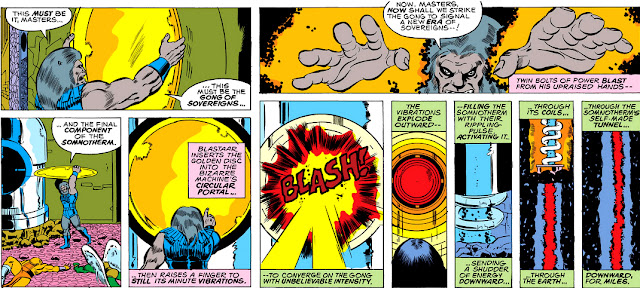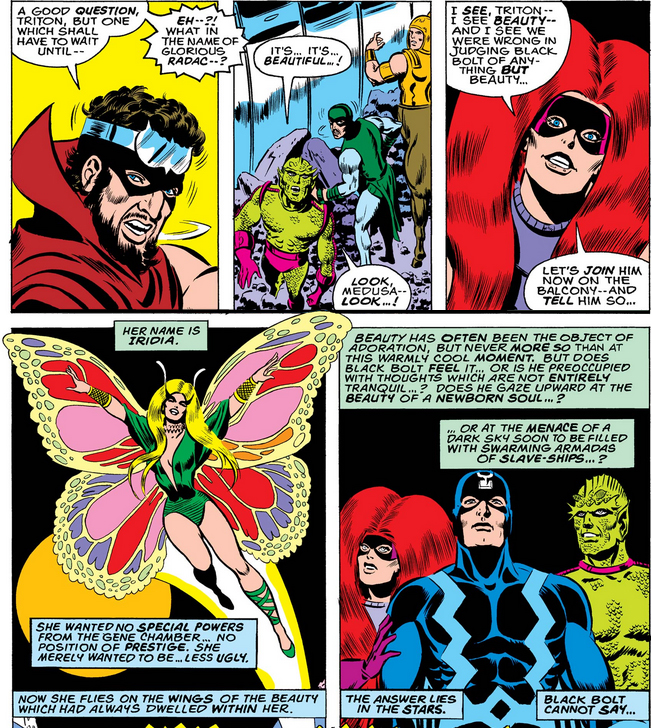Before writer Doug Moench rolled up his sleeves to tackle the first Inhumans mainstream series in 1975, there had been other attempts to explore this unique race in depth. The island of Attilan as well as the Inhumans' connection to the Kree were touched on in a backup feature written by Stan Lee and drawn by Jack Kirby to supplement the pages of Mighty Thor while also providing focus to Black Bolt and his family. The feature lasted for seven installments, and ended with the decision of Black Bolt (at the advice of Triton) to seek a new home for their Great Refuge.*
*The story was left to be continued indefinitely, and wouldn't be picked up again until thirteen years later by Peter Gillis and Ron Wilson (with Joe Sinnott) in the pages of What If, of all places (the Watcher would smooth things over in that regard), where the Eternals would offer their help in finding a suitable new site for the Refuge.
Just a little over two years later, the Inhumans would take up bi-monthly residence in Amazing Adventures (splitting the book with the Black Widow), their adventures helmed by scripters Jack Kirby, Roy Thomas, and Gerry Conway for ten issues before the book shifted gears to introduce and feature the new Beast.
Which takes us forward over three years to October of 1975 and The Inhumans, another bimonthly run for the group which lasted only twelve issues (eleven if you're not counting a reprint issue consisting of Kirby's initial Amazing Adventures story).
Scripted by Moench (and sporting a cover masthead style that's almost a dead ringer for that of the new Champions book launched the very same month), the series offered some noteworthy talent in artists George Perez, Gil Kane, and Keith Pollard, as Moench took a two-prong approach to the book--giving us glimpses of the Great Refuge and the ways of its people as well as the Royal Family, but spending the bulk of its time focusing on the Kree as they sought to re-establish their leash on this race which, on a whim, they had created during an experiment to evolve a tribe of primitive humans when landing on Earth millennia ago.
The fact that the Kree have blasted Blastaar (ha ha!) free from the adamantium alloy casing he was imprisoned in by the Hulk--using a bolt sent from another galaxy--gives us an idea of how serious they are about reclaiming the Inhumans. Equally impressive is that they've managed to collar Blastaar, a tough customer who normally wouldn't abide acceding to someone's will unless there were something in it for him.
Meanwhile, in the Great Refuge, the Royal Family is receiving disturbing tidings that something is amiss, spoken by a man who is disturbed himself--which may be an understatement when we're talking about someone often referred to as Maximus the Mad.
For now, Maximus's brother and king, Black Bolt, probably realizes there is no decisive action to take unless something further develops from these ravings--and so Moench pivots to matters of court, as the family gathers to hear petitions from the kingdom's subjects, the first of which presents an opportunity to reacquaint us with the ancient mists which the evolved Inhumans from ancient times developed on their own and used to empower many of their ilk. The request from the woman Iridia is a most humble one--though what's curious here is not just Gorgon's outrage in response, but making sense of the intent of a mute ruler who at times isn't obliged to explain his actions.
Unfortunately, Medusa's question comes at an inopportune time, as Blastaar reaches the outskirts of the Great Refuge while a portent of the warnings of Maximus breaks through to the royal palace itself. And unlike the Inhumans, who don't have the benefit of a comic reader's perspective, you've probably guessed that the timing of the two is more than a coincidence, thanks to the Kree--but the meaning of it all remains to be seen.
The departure of Black Bolt and Triton leaves the threat of Blastaar to be dealt with by their three cousins--though against an airborne attacker, their abilities to stop him will be limited since they are not conducive to use while in flight.** Still, one of them tries, though the effort backfires on all of them, leaving the one they were trying to stop at large in Attilan.
**It's not at all clear why Moench is keeping Crystal, another member of the Royal Family, under wraps during these events, as she simply "shows up" later when the dust settles; then again, since her elemental powers could deal with Blastaar quite handily even while he's in flight, perhaps we have our answer.
By now, we've reached the book's second issue, as the Kree's plans for the Champions er, Inhumans become apparent with Rich Buckler's cover that depicts the threat and purpose of the Kaptroids (now renamed from "Kapteroids"). And with their activation, we also come to understand the purpose of the "Somnotherm" which had burst through the palace floor and only needs a crucial part and a resonating burst of power to fulfill its purpose.
Thus far, it's been an intriguing beginning to this new series, as both Moench and Perez have kept a brisk pace featuring threats both known and unknown. But while the Inhumans remain ignorant of the reason(s) behind these aggressive moves against them, two men are closing in on yet another mystery, in the form of an ancient cavern containing a mass graveyard of the skeletal remains of what are presumed to be their ancestors; and as the Kaptroids burst up from beneath, Blastaar, far above, describes the doom that has been set in motion for Black Bolt and his people. As is usually the case, it turns out that Maximus has played a role in the crisis.
Naturally, Blastaar has zero interest in what happens to the Inhumans at this point, preferring to simply depart when the opportunity arises. Behind him, though, all hell breaks loose as the Inhumans must contend with two more Kaptroids, the first having been buried anew in the cavern by Black Bolt. The advance of the Kaptroids through the streets of Attilan must be a horrifying sight to the desperate, fleeing Inhumans who may be thinking they're seeing the end of their existence as they know it--with even their king appearing helpless to prevent their mass capture. The story has done its job here as far as making it possible for the reader to envision the worst--that when the sun rises the next day, the Great Refuge may be a ghost city, its former population having been retrieved by the Kree as slaves.
As we see, however, members of the Royal Family fight on--and thanks to the senses of Karnak in tandem with Triton's deduction, they've discovered the Somnotherm has another function besides being the means by which the Kaptroids are activated. And with its source of power shattered, the remaining Kaptroids topple like puppets with their strings clipped, to the annoyance no doubt of their alien masters who were figuratively pulling those strings.
As Triton has made clear, the Inhumans must now consider the Kree a clear and impending danger. But for what it's worth, the situation involving Iridia, which has also now rather fittingly come to fruition, provides a reminder to the people of Attilan that, although spawn of the Kree, they are a race unique that has come to deserve both their freedom and emancipation from those who regard them as chattel.
For the duration of the remaining issues of the book, there would be various attempts by Kree agents to subdue and capture the Inhumans--an indication that Moench had intended to make the conflict a story arc which would last for at least the first twelve issues and at some point see resolved. Once the book was cancelled in August of 1977, however, the story was grandfathered into Captain Marvel the following month where writer Scott Edelman integrates it into his own story involving the War of the Three Galaxies. It doesn't clean the slate as far as the relationship between the Kree and the Inhumans--but at least for the time being, it does table the issue of conscripting the Inhumans as Kree soldiers to fight against the Skrulls.



























I remember covering this story in UK's 'Blockbuster' monthly, a couple of months ago.
ReplyDeleteThe tale certainly looks a lot better in colour, as opposed to UK black & white. Strange, as, to me, George Perez's Avengers looks better in black & white (I suppose rich tone inkers, like Pablo Marcos, show up more in black & white.) Also, maybe colour helps, as the Inhumans' costumes, etc, are quite plain/nondescript, without the colour giving them a boost.
Also interesting, is that, comparing the pages here to the UK version, it looks like Marvel UK may have left a few panels on the cutting room floor - albeit, sometimes, with the Inhumans, it doesn't make that much difference.
I also noticed the Kaptroids/Kapteroids thing - weird!
Thanks for filling in whatever bits I forgot to mention - the contrast with the Inhumans Stan Lee origin, at the end, is a really nice finishing touch.
Thanks for another great article. I know the time & effort it takes you to write these.
Phillip
Phillip, you make some good points regarding the use of color vs. black and white, which perhaps help to explain why the Essential series seemed to do so well. Both methods depend on the talents of the embellisher; though there are no doubt instances where the scripter might be at a loss when, say, a member of the Kree or an Atlantean might make derogatory references to "pink-skinned" Kree or surface dwellers (or, for that matter, Namor) or other color-based points of reference such as the Hulk's nickname of "greenskin," the flames of the Human Torch (unless they stick to "white-hot"), the effects of the "green flu" afflicting everyone in Hulk Annual #11, the Golden Avenger, etc., etc.
ReplyDeleteAnd thanks for the nice words! Blogging does take a little rolling up of the sleeves and an eye on the clock, but as long as I don't develop a caffeine habit I'll stick to it! :D